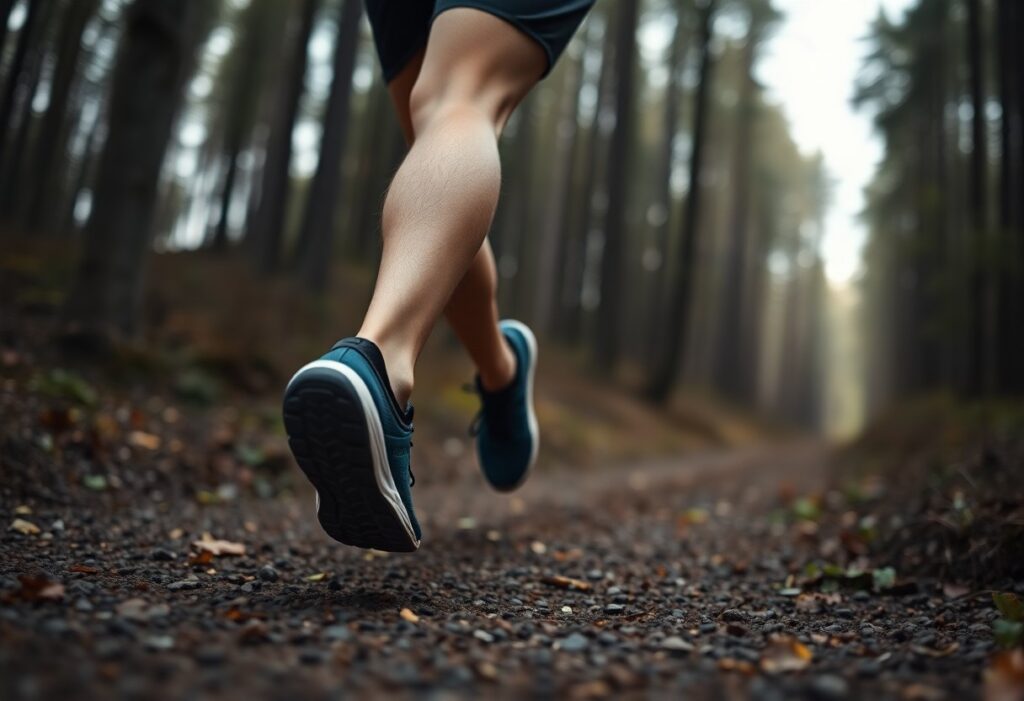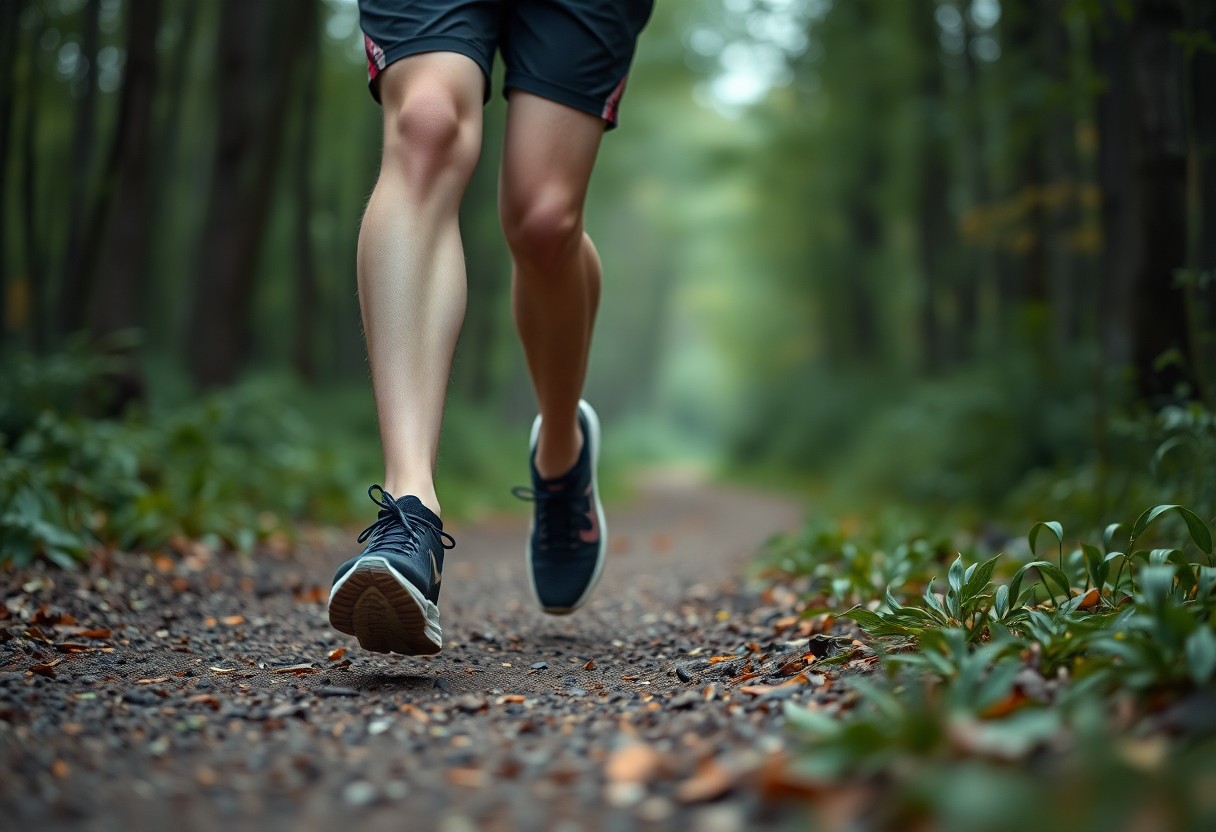
The alarming challenge of injury rates affecting trail runners can escalate to a concerning 62% annually. This is often linked to the use of unsuitable footwear. Understanding the biomechanics of minimalist footwear and its interaction with uneven terrain is crucial for improving your running performance while reducing injury risks. The integration of wearable technology can effectively monitor critical metrics like foot strike dynamics and load patterns, alongside personalised training programmes aimed at enhancing foot strength and endurance. This article explores how to leverage biomechanical insights and advanced technology for effective injury prevention strategies.

Make Smart Footwear Choices to Elevate Your Trail Running Skills
When tackling the diverse and rugged landscape of trail running while donning minimalist footwear, it is imperative to possess more than just a selection of suitable shoes; you must also develop a comprehensive understanding of your personal biomechanics. Neglecting to recognise the distinct demands presented by various trail surfaces can markedly increase your likelihood of injury. Given that foot strike patterns and descent mechanics differ significantly, it is vital to adapt your running technique to ensure you maintain peak performance while reducing the risk of injury. By incorporating your knowledge of biomechanics into your training regimen, you can make informed decisions that will greatly enhance your trail running experience.
Examine Biomechanical Foot Strike Patterns on Varied Trail Conditions
Foot strike dynamics can fluctuate considerably when navigating complex landscapes. Runners using minimalist footwear frequently exhibit a significant 23% increase in midfoot strikes on uneven trails, contrasting starkly with the mere 8% observed when using traditional running shoes. This adaptation can enhance your stability on challenging surfaces, yet it also results in a 37% increase in metatarsophalangeal joint flexion angles. This clearly indicates the necessity for strengthening your foot muscles to improve endurance and decrease injury risk. By understanding these dynamics, you can modify your running form to not only boost performance but also minimise the chances of injury, thereby ensuring that you remain resilient on demanding trails.
Evaluate Descent Mechanics and Their Impact on Ground Interaction
The mechanics involved in descending from elevations are pivotal in influencing your performance and injury risk in trail running. When wearing minimalist footwear, you may experience an alarming 42.191 BW/s increase in vertical loading rates on steep 15% declines, particularly when compared to flat asphalt surfaces. Additionally, this surge in loading leads to increased lateral toe engagement, which has been noted to be 11% higher on loose gravel than on more structured surfaces, highlighting the increased demands placed on the structural integrity of your feet during descents. As you navigate technical trails in minimalist shoes, the biomechanics of your feet engage in a unique manner that warrants careful consideration.
The heightened vertical loading rates encountered during descents can lead to increased fatigue in your foot muscles, thus raising your susceptibility to injuries. Moreover, significant alterations in toe splay patterns necessitate improved proprioception and muscle coordination, ensuring that you remain responsive to the varying terrain underfoot. By focusing on these factors, you can effectively prepare your body to face the challenges of diverse trails while optimising your overall running performance and safeguarding against injury.
Critically Assess the Limitations of Wearable Technology in Trail Running
Although wearable technology has revolutionised the realm of trail running, it also presents significant challenges in accurately tracking performance metrics. The variability of terrain conditions, which may include steep inclines and uneven surfaces, complicates the data collection and interpretation processes. For example, wearable devices often struggle to provide consistent vertical oscillation measurements due to the fluctuating ground conditions, which may result in misleading insights regarding your gait and running efficiency. Grasping these limitations is essential for making informed choices about your training methods and ensuring a more reliable assessment of your performance metrics.
Explore Data Accuracy Discrepancies Between Top Performance Tracking Devices
There have been notable discrepancies in data accuracy across leading performance tracking devices. A 2024 study revealed a 12.4% variance in power measurements on 10% inclines between the Stryd and GARMINRP devices, despite both demonstrating high intra-device reliability (ICC=0.89). Such inconsistencies can lead to misguided perceptions regarding your training load and overall performance, potentially obstructing your ability to optimise your trail running capabilities. Being cognisant of these discrepancies allows you to critically evaluate the data provided by these devices and make necessary adjustments to your training strategies.
and GARMINRP devices, despite both demonstrating high intra-device reliability (ICC=0.89). Such inconsistencies can lead to misguided perceptions regarding your training load and overall performance, potentially obstructing your ability to optimise your trail running capabilities. Being cognisant of these discrepancies allows you to critically evaluate the data provided by these devices and make necessary adjustments to your training strategies.
The Serious Implications of Miscalculating Training Loads
Inaccuracies in training loads can escalate by as much as 23% on mixed-terrain routes, directly influencing your injury risk and performance progression. This often results from misinterpretations of data during technical descents or uneven terrains, compelling you to rely on potentially flawed metrics. Such discrepancies can lead to overtraining or inadequate load management, substantially increasing your likelihood of sustaining an injury while running. It is therefore vital to regularly assess the accuracy of your training data to ensure that you are progressing safely and effectively.
As you traverse complex trail surfaces, the disparity between measured and actual exertion can distort your training insights. If your device underreports your exertion levels, you might unknowingly exceed your limits, resulting in heightened fatigue and delayed recovery. Conversely, if your training load is overestimated, you may adopt a more conservative approach, inadvertently hindering your performance gains. In summary, ensuring that your wearable technology informs rather than misleads your training strategy is essential for maintaining both performance and overall health in the dynamic landscape of trail running.
Gain Insight into Gender Dynamics Affecting Trail Running Biomechanics
Acquiring a nuanced understanding of the biomechanical differences between male and female trail runners can greatly enhance performance and reduce injury risks. Research demonstrates that anatomical and physiological variations influence shoe selection, gait patterns, and susceptibility to injuries. Customising footwear and training programmes based on these gender-specific dynamics fosters safer and more effective outdoor running experiences, enabling both male and female athletes to achieve their best performances while remaining injury-free.
Explore Gender-Specific Biomechanical Reactions Post-Exercise
Following exercise, female runners exhibit a 19% increase in lateral forefoot pressures compared to their male counterparts after completing 5km barefoot runs. Furthermore, they demonstrate a 22% reduction in navicular drop during 50km ultra-marathons, indicating that their biomechanical adaptations to trail running are distinctly different. Recognising these patterns is crucial for enhancing footwear design that accommodates the unique biomechanics of female runners. Tailoring your training and gear to these differences can lead to improved safety and performance for all athletes.
Implement Targeted Gender-Specific Solutions for Effective Injury Prevention
To successfully address the unique biomechanics of female runners, implementing customised solutions that consider their specific physical characteristics is essential. Tailoring training programmes, selecting gender-appropriate footwear, and enhancing strength regimens can significantly reduce injury rates while improving overall running performance. For example, integrating exercises focused on intrinsic foot muscle endurance and stability can be particularly advantageous for women, who may experience varying loading patterns on technical terrains. This personalised approach ensures that all runners can train effectively while prioritising their unique biomechanics.
By analysing data from diverse studies and incorporating findings on gender-specific responses, you can better focus on training and footwear that actively support your unique biomechanics. For instance, adopting targeted strength training regimens aimed at enhancing the lower leg and foot can help your body adapt to the increased demands of trail running, particularly for women who often face heightened pressure in the forefoot region. Selecting shoes specifically designed for your unique foot mechanics can further assist in addressing common injuries, ultimately promoting a more rewarding and sustainable trail running experience.

Leverage Innovative Real-Time Gait Analysis Techniques to Boost Performance
Enhancing your running performance and safety can be achieved through the adoption of real-time gait analysis utilising advanced technological methods. By employing integrated systems and wearable devices, you gain immediate feedback regarding your foot strike patterns, body mechanics, and overall movement efficiency. These sophisticated tools are designed to provide actionable insights while you are actively on the trail, empowering you to adapt your technique dynamically and prevent repetitive strain injuries commonly associated with improper running form. Embracing these technologies can significantly improve your skills and enrich your trail running experience.
Understand the Role of Embedded Sensors in Preventing Injuries During Trail Running
Embedded sensors within footwear play a critical role in injury prevention. They continuously monitor your foot strike patterns and pressure distributions in real-time, enabling immediate corrective feedback. This advanced technology allows you to identify deviations from optimal running mechanics before they escalate into serious injuries. With an impressive 19-millisecond latency in ground contact alerts, you receive timely notifications that assist in maintaining alignment with biomechanical standards essential for injury avoidance. Leveraging this technology can greatly enhance your training effectiveness and overall safety.
Longitudinal Studies Show the Efficacy of Biometric Feedback Technologies on Injury Rates
Long-term studies indicate significant reductions in injury rates among trail runners who utilise biometric feedback technologies. Over a six-month period, athletes reported a 37% decrease in aberrant loading patterns due to ongoing monitoring and adjustments informed by real-time data. This compelling evidence highlights how sustained engagement with these technologies can improve your running economy and resilience, thereby reducing the likelihood of injuries related to gait abnormalities. By incorporating these insights into your training, you can proactively safeguard your health and enhance performance.
For instance, a comprehensive study involving 250 trail runners documented the effectiveness of wearable sensors in identifying patterns that lead to overuse injuries. Runners who actively engaged with feedback systems reported a 30% lower incidence of common injuries such as plantar fasciitis and Achilles tendinitis compared to those who relied solely on traditional training methods. The emphasis on continuous tracking, coupled with targeted adjustments based on data insights, highlights a growing trend toward a more proactive approach to injury prevention within the realm of trail running.
Key Takeaways on Biomechanics and Trail Running Performance
Ultimately, a thorough understanding of the biomechanics involved in trail running while using minimalist footwear is essential for maximising performance and minimising the risk of injury. By effectively integrating wearable technology and adopting tailored training methodologies, you can significantly enhance both your foot strength and adaptability to various terrains. Regularly cross-validate metrics from different devices and utilise advanced tools to monitor your gait, thereby personalising your training regimen. This approach not only supports your running journey but also promotes sustainable practices in your outdoor activities. With the right knowledge and tools at your disposal, you can enjoy a more fulfilling and injury-free trail running experience.
The Article Trail Running Biomechanics in Minimalist Footwear: Integrating Wearable Technology and Injury Prevention Strategies appeared first on My Shoes Finder
The Article Trail Running Biomechanics: Injury Prevention with Minimalist Shoes Was Found On https://limitsofstrategy.com
The Article Injury Prevention in Trail Running with Minimalist Shoes found first on https://electroquench.com







